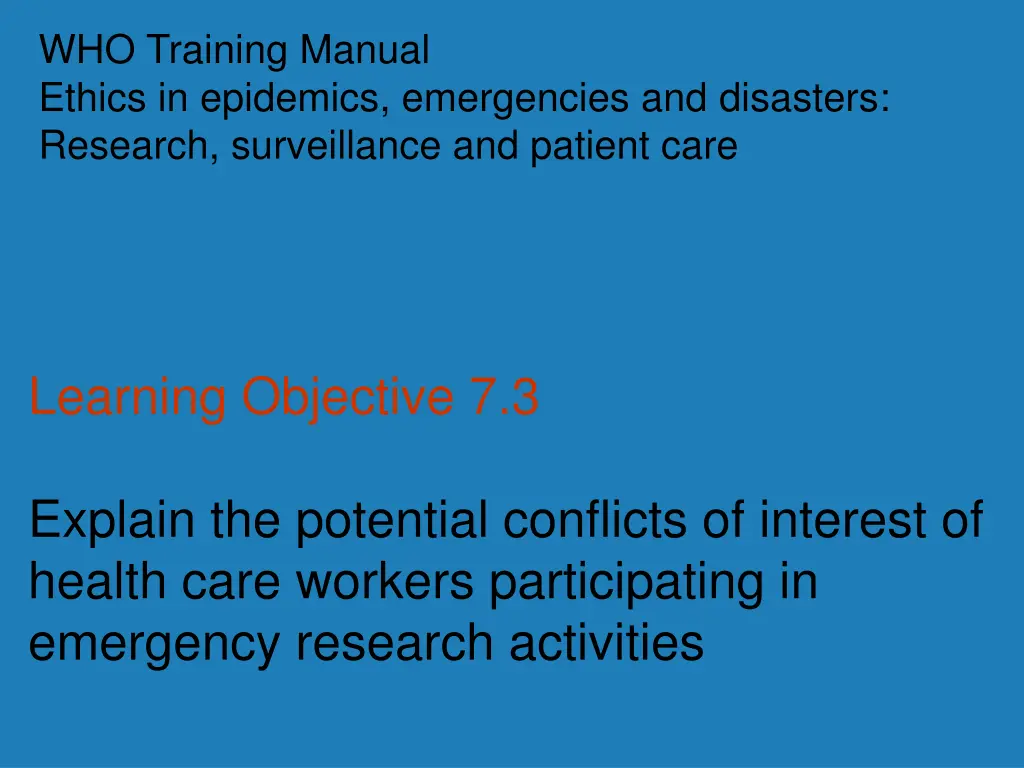
Understanding Conflicts of Interest in Emergency Research Activities
Explore the potential conflicts of interest faced by health care workers involved in emergency research activities. Learn about financial and non-financial interests, and how to manage conflicts of interest in practice. Gain insights through key definitions, problem-solving tools, case studies, and discussions.
Download Presentation

Please find below an Image/Link to download the presentation.
The content on the website is provided AS IS for your information and personal use only. It may not be sold, licensed, or shared on other websites without obtaining consent from the author. If you encounter any issues during the download, it is possible that the publisher has removed the file from their server.
You are allowed to download the files provided on this website for personal or commercial use, subject to the condition that they are used lawfully. All files are the property of their respective owners.
The content on the website is provided AS IS for your information and personal use only. It may not be sold, licensed, or shared on other websites without obtaining consent from the author.
E N D
Presentation Transcript
WHO Training Manual Ethics in epidemics, emergencies and disasters: Research, surveillance and patient care Learning Objective 7.3 Explain the potential conflicts of interest of health care workers participating in emergency research activities
Outline 1. Key definitions and concepts 2. Problem solving tools and the model for the ethical management of conflicts 3. Case study 4. Discussion 5. Wrap up Suggested time 0-15 (15 min) 16-25 (10 min) 26-55 (30 min) 56-85 (30 min) 86-90 (5 min) Activity Summary and conclusion Introduction Presentation problem-solving tools Case study and discussion, phase 1 Case study and discussion, phases 2 and 3 L.O. 7.3
Definition: Conflict of Interest A situation in which a person has a private or personal interest sufficient to appear to influence the objective exercise of his or her official duties as, say, a public official, an employee, or a professional. (MacDonald, McDonald and Norman 2002) Any factor that might tend to undermine a competent researcher s ability to make scientifically reliable judgments concerning research strategy, evidence or conclusions. (Davis 1999) A set of circumstances that creates a risk that professional judgment or actions regarding a primary interest will be unduly influenced by a secondary interest. (Institute of Medicine 2009) L.O. 7.3
Financial Interests Recruiting patients Research grants Stock options L.O. 7.3
Non-financial Interests If there s no money, there s no conflict Tendency to focus on what s measurable ($$$) Non-financial interests often ignored completely Given much less attention in policies Not considered very harmful Less problematic than financial interests Recognizing these threatens professional identity Objectivity, neutrality, independence Non-financial interests can be especially problematic, because they are less recognized and less understood. L.O. 7.3
Case Study Determining the workforce costs of the AIDS epidemic L.O. 7.3
Managing COI in Practice Being in a COI is not unethical the issue is how to handle it. Guidance: 1. Identify COI, avoid when possible 2. Discuss with all concerned 3. Remove person from sensitive decisions Sometimes 1 and 3 are impossible. So 2 (transparency & dialogue) becomes crucial. L.O. 7.3
A Model for Ethical COI Management in Public Health Identifying the actors Where in the world are the COI? They re in the researcher and in the research setting Phase 1 The Context What is and What if? Phase 2 Take Home Messages What can we do better in the future? Phase 3 L.O. 7.3
A Model for Ethical COI Management in Public Health Educational PHASE Know what a COI is and appropriate policies Financial or non-financial? What policies are you subject to? Know yourself, the actors and evaluate the risk Where in the world are the COI? They re in the researcher and in the research setting Who s involved, what are their/your interests? Is there a problematic COI situation (actual/potential; financial/non-financial)? PHASE 1 Know the context and how to manage it What is? and What if? What are the benefits/risks of different resolution strategies? PHASE 2 Take Home Messages What can we do better in the future: As a team - for future education and practice In terms of practice - to inform policy makers. PHASE 3 L.O. 7.3
Summary 1. Beyond a pejorative view of conflict of interest 2. Attention to non-financial and institutional COI 3. Recognise some COI are endemic, unavoidable 4. Be proactive and systematic: Better prevent than cure 5. Use & limits of policies, procedures, guidelines 6. Self-awareness, humility 7. Discuss integrity & ethical conduct L.O. 7.3
Sources MacDonald, C.; McDonald, M.; Norman, W. 2002. Charitable Conflicts of Interest Journal of Business Ethics 39(1): 67-74. Davis, M. 1999. Ethics and the University (London, UK: Routledge) Institute of Medicine. Conflict of Interest in Medical Research, Education, and Practice. Edited by B. Lo and M.J. Field, Washington, D.C.: Institute of Medicine Committee on Conflict of Interest in Medical Research, Education, and Practice, National Academies Press, 2009. http://www.nap.edu/catalog.php?record_id=12598 L.O. 7.3
Acknowledgements Chapter authors Potvin, Marie-Jos e, Reproductive Ethics Research Group, School of Public Health, Universit de Montr al, Montr al, Qu bec, Canada Williams-Jones, Bryn, Department of Social and Preventive Medicine, School of Public Health, Universit de Montr al, Montr al, Qu bec, Canada L.O. 7.3
